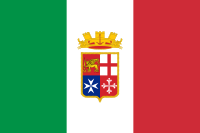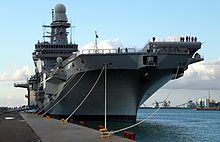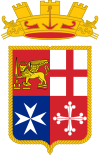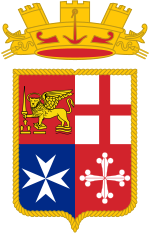- Italian Navy
-
For other uses, see Italian Navy (disambiguation).
Italian Navy
Marina Militare
Coat of Arms of the Italian NavyActive 1946 – Present
(1713 as Regia Marina)Country Italy Branch Navy Type Navy Size 35,200 active personnel 180 commissioned ships, 123 aircraft
Motto Italian: Patria e Onore
"Country and Honour"Anniversaries June 10 - Sinking of the Austro-Hungarian battleship SMS Szent István by Luigi Rizzo Commanders capo di stato maggiore della marina ammiraglio di squadra
Paolo Goberiussottocapo di stato maggiore della marina ammiraglio di squadra
Luigi Binelli MantelliInsignia Naval Aviation roundels 

Naval Ensign 
The Italian Navy (Marina Militare) is the navy of the Italian Republic. It is one of the four branches of military forces of Italy; formed in 1946, from what remained of the Regia Marina (Royal Navy). As of 2008, the Italian Navy had 35,200 active personnel with 180 commissioned ships, 19 Floating Docks, and 123 aircraft. The total displacement of the navy is between 293,000 to 300,000 tons.[1]
Contents
Ensign
The ensign of the Italian Navy is the Italian tricolour defaced with the coat of arms of the Marina Militare. The quarters refer to the four Medieval Italian Thalassocracies, or "Maritime Republics" (Italian: Repubbliche Marinare):
- 1st quarter: on red, a golden winged lion wielding a sword (Republic of Venice);
- 2nd quarter: on white field, red cross (Republic of Genoa);
- 3rd quarter: on blue field, white cross (Republic of Amalfi);
- 4th quarter: on red field, white cross (Republic of Pisa).
The shield has a golden crown, that distinguish military vessels from merchant: the crown, "Corona rostrata", was proposed in 1939 by Admiral Domenico Cavagnari to the Government, as an acknowledgement of the Italian Navy's origin in Roman times. In the proposal, Adm. Cavagnari wrote that "in order to recall the common origin [of the Navy] from the Roman sailorship, the Insignia will be surmounted by the towered Crown with rostrums, the emblem of honour and valour the Roman Senate awarded to the leaders of naval victories, conquerors of lands and cities across the seas".
A further difference is that St. Mark's lion, symbolising the Republic of Venice, does not hold the gospel in its paw (as it does on the civil ensign, where the book is open at the words "Pax tibi Marce, evangelista meus", meaning "Peace to you Mark, my Evangelist") and is wielding a sword instead: such an image is consistent with the pictorial tradition, in which the book is shown open during peacetime and closed during wartime.
History
Before and during World War II
Main article: Regia MarinaThe Regia Marina was formed on 17 March 1861, after the proclamation of the Kingdom of Italy, The Italian Navy assumed its present name after the Italian monarchy was abolished following a popular referendum held on 2 June 1946.
After World War II
At the end of its five years involvement in World War II, Italy was a devastated nation. After the end of hostilities the Regia Marina, which at the beginning of the war was the fourth largest navy in the world with a mix of modernised and new battleships, started a long and complex rebuilding process. The important combat contributions of the Italian naval forces after the signing of the armistice with the Allies on 8 September 1943 and the subsequent cooperation agreement on 23 September 1943 left the Regia Marina in a poor condition, with much of its infrastructure and bases unusable and its ports mined and blocked by sunken ships. However, a large number of its naval units had survived the war, albeit in a low efficiency state, which was due to the conflict and the age of many vessels. The vessels that remained were:
- 2 aircraft carriers
- 5 battleships
- 9 cruisers
- 11 destroyers
- 22 frigates
- 19 corvettes
- 44 fast coastal patrol units
- 50 minesweepers
- 16 amphibious operations vessels
- 2 school ships
- 1 support ship and plane transport
- various submarine units
The peace Treaty
The Peace Treaty signed on February 10, 1947 in Paris was onerous for Regia Marina. Apart from territorial and material losses, also the following restrictions were imposed:
- A ban to own, to build or to experiment with atomic weapons, self-propulsion projectiles or relative launchers, etc.…
- A ban to own Battleships, Aircraft carriers, Submarines and Amphibious Assault units.
- A ban to operate military installations on the islands of Pantelleria, Pianosa and on the archipelago of Pelagie Islands.
The treaty also ordered Italy to put the following ships at the disposals of the victorious nations United States, Soviet Union, Great Britain, France, Greece, Yugoslavia and Albania as war compensation:
- 3 Battleships: Giulio Cesare, Italia, Vittorio Veneto;
- 5 Cruisers: Emanuele Filiberto Duca d'Aosta, Attilio Regolo, Scipione Africano, Eugenio di Savoia and Eritrea;
- 7 Destroyers, 5 of the "Soldati" class and Augusto Riboty and Alfredo Oriani;
- 6 Minesweepers: like Aliseo and Fortunale;
- 8 Submarines: 3 of the "Acciaio" class;
- 1 Sailing School ship: Cristoforo Colombo.
The total displacement, battleships excluded, of the future navy was not allowed to be greater than 67,500 tons, while the staff was capped at 25,000 men.
The entry into NATO
Great changes in the international political situation which were developing into the Cold War convinced the United Kingdom and United States to discontinue the transfer of Italy's capital ships as war reparations. Some had already been dismantled in La Spezia between 1948 and 1955, including the flagship aircraft carrier "Aquila". The Soviet Union, however, demanded the surrender of the warship "Giulio Cesare" and other naval units designated for transfer. The cruisers "Attilio Regolo" and "Scipione Africano" became the French "Chateaurenault" and "Guichen", while the "Eugenio di Savoia" became the Greek "Helli". After break up and/or transfers, only a small part of the fleet remained to be recommissioned into the Marina.
As Western attention turned to the Soviets and the Mediterranean Sea, Italian seas became one of the main sites of confrontation between the two superpowers, contributing to the re-emergence of Italy’s naval importance thanks to her strategic geographical position.
With the new elections in 1946, the Kingdom of Italy became a Republic, and the Regia Marina took the name of Marina Militare (Military Navy). As the Marshall Plan began to rebuild Italy and Europe was rapidly being divided into two geo-politically antagonistic blocs, Italy began talks with the United States to guarantee adequate security considerations. The government in Washington, wished to keep its own installations on the Italian Peninsula and relaxed the Treaty restrictions by including Italy in the Mutual Defense Assistance Programme (MDAP).
 The Italian navy is often involved in combined NATO operations: here Marina Militare ships Maestrale and Durand de la Penne open and close this 5-nations fleet in the Oman sea.
The Italian navy is often involved in combined NATO operations: here Marina Militare ships Maestrale and Durand de la Penne open and close this 5-nations fleet in the Oman sea.
On 4 April 1949, Italy joined the North Atlantic Treaty Organisation (NATO), and in order for the navy to contribute actively in the organization, the Treaty restrictions were definitively repealed by the end of 1951, with the consent of all of Western nations. However, the country was still banned from possessing aircraft carriers until 1989.
Within NATO, the Marina Militare was assigned the control of the Adriatic Sea and Strait of Otranto, as well as the defence of the naval routes through the Tyrrhenian Sea. To ensure these tasks a "Studio sul potenziamento della Marina italiana in relazione al Patto Atlantico" (Study about the Development of the Italian navy with reference to the Atlantic Pact) was undertaken, which researched the structures and the methods for the development of the Marina Militare.
This solution required a great economic effort to rebuild and transform the fleet; it also required aid from the United States to reach the necessary standards. Progress was slow due to economic pressures on Italy due to post-war rebuilding and some European governments who were concerned at seeing an Italian Navy capable of rivaling the Western naval forces imposed political obstacles to prevent Italian naval development.
Present-day Marina Militare
 The new Cavour aircraft carrier.
The new Cavour aircraft carrier.
Today's Marina Militare is a modern navy with ships of every type, such as:
- 2 aircraft carriers,
- 4 destroyers
- 8 frigates
- 4 light patrol frigates
- 6 submarines
- 8 corvettes
- 14 patrol boat
- 3 landing platform docks
- 15 auxiliares
- Approximately 132 auxiliary, training and landing craft vessels.
The fleet is in continuous evolution; the Marina Militare is now equipping herself with a bigger aircraft carrier (the Cavour), new destroyers, submarines and multipurpose frigates. In modern times, the Marina Militare, being a member of the North Atlantic Treaty Organisation (NATO), has taken part in many coalition peacekeeping operations. The "Marina Militare" maintains the San Marco Regiment who serve as the marines of the Italian navy.
Structure and organization
Components Organization · Corps of the Port Captaincies – Coast Guard · COMSUBIN · San Marco Regiment

Command Equipment History and traditions Structure
Marina Militare is divided into seven corps (by precedence):
- Corpo di stato maggiore - Corps of Staff Officers (SM) (line officers)
- Corpo del genio navale - Corps of Naval Engineering (GN)
- Corpo delle armi navali - Corps of the Naval Arms (AN)
- Corpo sanitario militare marittimo - Maritime Military Medical Corps (MD) for medics; (FM) for Pharmacists
- Corpo di commissariato militare marittimo - Corps of Military Maritime Commissariat (CM) (administration)
- Corpo delle capitanerie di porto - Corps of the Port Captaincies (CP) the coast guard
- Corpo degli equipaggi militari marittimi - Corps of the Military Maritime Crews (CEMM)
Organization
- Capo di Stato Maggiore della Marina (Navy Chief of Staff)- Ammiraglio di squadra Bruno Branciforte
- Sottocapo di Stato Maggiore della Marina (Navy Deputy Chief of Staff)- Ammiraglio di squadra Maurizio Gemignani
- Fleet Command - Comandante in Capo della Sqaudra Navale (CINCNAV) Ammiraglio di squadra Luigi Binelli Mantelli
- Comando Forze d'Altura COMFORAL (based in Taranto): ships Garibaldi, Espero, Etna, Durand de la Penne, Mimbelli, San Giorgio, San Marco, San Giusto, Elettra
- COMSQUAFR 1 (based in Taranto): ships Aliseo, Euro, Zefiro, Espero, Artigliere, Bersagliere, Granatiere, Aviere, Stromboli
- COMSQUAFR 2 (based in La Spezia): ships Maestrale, Grecale, Libeccio, Scirocco, Vesuvio
- Comando delle Forze da Pattugliamento per la Sorveglianza e la Difesa Costiera COMFORPAT (based in Augusta):
- COMSQUACORV: ships Minerva, Urania, Danaide, Sfinge, Chimera, Driade, Fenice, Sibilla
- COMSQUAPAT 1: ships Cassiopea, Libra, Spica, Vega
- COMSQUAPAT 2: ships Cigala Fulgosi, Borsini, Foscari, Bettica, Sirio, Orione
- Comando delle Forze Anfibie COMFORSBARC (based in Brindisi):
- San Marco Regiment
- Logistics and Training Regiment Carlotto
- Gruppo Mezzi da Sbarco
- Comando Forze Subacquee COMFORSUB (based in Taranto):
- COMGRUPSOM: submarines Da Vinci, Pelosi, Prini, Longobardo, Gazzana, Todaro, Scirè
- Centro di Addestramento Aeronavale MARICENTADD
- Comando Forze Aeree COMFORAER (based in Santa Rosa)
- Centro per le Telecomunicazioni e l'Informatica MARITELE (based in Roma)
- Comando delle Forze di Contromisure Mine COMFORDRAG (based in La Spezia):
- COMSQUADRAG 53: ships Numana, Rimini, Sapri, Termoli, Viareggio, Vieste
- COMSQUADRAG 54: ships Alghero, Chioggia, Crotone, Gaeta, Lerici, Milazzo
- Quartier Generale Marina QUARTGENMARINA (based in Roma)
- Comando Forze d'Altura COMFORAL (based in Taranto): ships Garibaldi, Espero, Etna, Durand de la Penne, Mimbelli, San Giorgio, San Marco, San Giusto, Elettra
For the Italian Navy rank structure see: Italian Navy ranks.
Ships
Further information: List of Italian Navy shipsAircraft
Aircraft Origin Type Versions In service[2] Agusta-Bell 212  Italy
ItalyASW/ASuW helicopter AB-212ASW 25 Utility helicopter AB-212ASH 6 Agusta-Sikorsky ASH-3D Sea King  Italy
ItalyASW/ASuW helicopter ASH-3DASW 8 Amphibious support helicopter ASH-3DASH 8 AgustaWestland EH101  Italy
ItalyASW/ASuW helicopter 110-ASW 8 Amphibious support helicopter 410-ASH 4 Tactical transport helicopter 410-TTH 4 Airborne early warning 112-AEW 4 Boeing AV-8B Harrier II  United States/
United States/ United Kingdom
United KingdomGround-attack aircraft AV-8B 16 Two lost due to accidents. Trainer aircraft TAV-8B 2 References
- ^ http://www.hazegray.org/worldnav/
- ^ "The Military Balance 2010", page 143. International Institute for Strategic Studies, 2010-02-03.
External links
 Esercito Italiano (Army)
Esercito Italiano (Army)  Marina Militare (Navy)
Marina Militare (Navy)  Aeronautica Militare (Air Force)
Aeronautica Militare (Air Force)  Carabinieri (Gendarmerie)Ship classes of the Marina Militare
Carabinieri (Gendarmerie)Ship classes of the Marina MilitareAircraft carriers 
Amphibious transport docks Destroyers and frigates Corvettes and patrol boats Auxiliary ships navies in Europe
Sovereign
states- Albania
- Andorra
- Armenia
- Austria
- Azerbaijan
- Belarus
- Belgium
- Bosnia and Herzegovina
- Bulgaria
- Croatia
- Cyprus
- Czech Republic
- Denmark
- Estonia
- Finland
- France
- Georgia
- Germany
- Greece
- Hungary
- Iceland
- Ireland
- Italy
- Kazakhstan
- Latvia
- Liechtenstein
- Lithuania
- Luxembourg
- Macedonia
- Malta
- Moldova
- Monaco
- Montenegro
- Netherlands
- Norway
- Poland
- Portugal
- Romania
- Russia
- San Marino
- Serbia
- Slovakia
- Slovenia
- Spain
- Sweden
- Switzerland
- Turkey
- Ukraine
- United Kingdom
- Vatican City
States with limited
recognition- Abkhazia
- Kosovo
- Nagorno-Karabakh Republic
- Northern Cyprus
- South Ossetia
- Transnistria
Categories:- Naval ships of Italy
- Marina Militare
Wikimedia Foundation. 2010.



